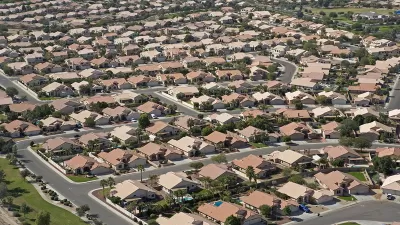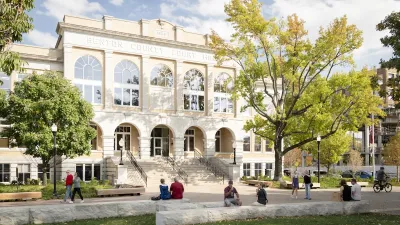What's so special about single-family homes that we'd rather preserve them than prevent the displacement and financial distress of thousands of low- and moderate-income renters?
As everyone knows by now, quite a few American cities—downtowns in particular—are doing really well. That's great news, but it hasn't come without some cost. Chief among those costs is a growing concern about increasing unaffordable housing and the displacement that often accompanies it. That is to say, gentrification. Though its fundamental causes are often misunderstood and misattributed, gentrification is nonetheless a serious issue. It's also an issue that, judging by the lack of any meaningful solutions after several decades of trying, is quite difficult to solve.
While I've argued in the past that gentrification (and rapid growth in general) is somewhat inevitable in many neighborhoods, what I didn't talk about is what those neighborhoods tend to look like. Specifically, that those neighborhoods are usually disproportionately represented by renters, not homeowners. (And middle-class gentrifiers who moved in two years ago complaining about the upper-middle-class gentrifiers who moved in two weeks ago.)
And its this focus on rental neighborhoods that's the paradox of gentrification to me. Most cities have thousands upon thousands of acres of land devoted solely to single-family homes, maybe with some duplexes here and there, usually with 6-8 homes per acre. Much of that land is very conveniently adjacent to major job centers and amenities (think Wallingford in Seattle, Boyle Heights in Los Angeles). Most of the homes on that land are owned by their residents. Yet when we choose where we're going to allow new density (and where we'll build new transit infrastructure) we focus it in the neighborhoods with the largest share of people who won't benefit financially—renters living on the edge of affordability lose, absentee property owners win. With outcomes like that, it's not surprising that many people feel so negatively about developers and new construction.
Now, I sincerely believe there are other benefits to increasing density, like the range of new cultural, food, and entertainment options that usually accompany concentrated groups of people. I also think new developments need to go somewhere, because choosing not to build housing doesn't stop people from finding your city a desirable place to live—it just means more people bidding over fewer homes. And it's completely sensible to maximize the return on public investments like subways and bus rapid transit by allowing as many people as possible to live and work near those resources. But there are quite a few low-density, mostly single-family neighborhoods and parts of neighborhoods that are also very conveniently located, and they're completely off-limits to new development. In many cases, even new buildings as low-key and unobtrusive as accessory dwelling units (or "granny flats") are prohibited or prohibitively over-regulated.
And the sad thing is that if those neighborhoods were opened up to some meaningfully higher level of development—that is, given the opportunity, not forced—homeowners would be in a position to gain in a way that renters can't. Gentrification would be a meaningless term in these places, because any increase in value would equate to increased wealth for residents.
There would be challenges with parking, views, and privacy, among other things, but they'd be the same challenges you find in every growing neighborhood, regardless of who owns the buildings. And whatever issues homeowners must contend with in a developing area, renters must contend with that plus increasingly unaffordable housing. What's so special about single-family homes that we'd rather preserve them than prevent the displacement and financial distress of thousands of low- and moderate-income renters?

Alabama: Trump Terminates Settlements for Black Communities Harmed By Raw Sewage
Trump deemed the landmark civil rights agreement “illegal DEI and environmental justice policy.”

Planetizen Federal Action Tracker
A weekly monitor of how Trump’s orders and actions are impacting planners and planning in America.

The 120 Year Old Tiny Home Villages That Sheltered San Francisco’s Earthquake Refugees
More than a century ago, San Francisco mobilized to house thousands of residents displaced by the 1906 earthquake. Could their strategy offer a model for the present?

In Both Crashes and Crime, Public Transportation is Far Safer than Driving
Contrary to popular assumptions, public transportation has far lower crash and crime rates than automobile travel. For safer communities, improve and encourage transit travel.

Report: Zoning Reforms Should Complement Nashville’s Ambitious Transit Plan
Without reform, restrictive zoning codes will limit the impact of the city’s planned transit expansion and could exclude some of the residents who depend on transit the most.

Judge Orders Release of Frozen IRA, IIJA Funding
The decision is a victory for environmental groups who charged that freezing funds for critical infrastructure and disaster response programs caused “real and irreparable harm” to communities.
Urban Design for Planners 1: Software Tools
This six-course series explores essential urban design concepts using open source software and equips planners with the tools they need to participate fully in the urban design process.
Planning for Universal Design
Learn the tools for implementing Universal Design in planning regulations.
Clanton & Associates, Inc.
Jessamine County Fiscal Court
Institute for Housing and Urban Development Studies (IHS)
City of Grandview
Harvard GSD Executive Education
Toledo-Lucas County Plan Commissions
Salt Lake City
NYU Wagner Graduate School of Public Service






























